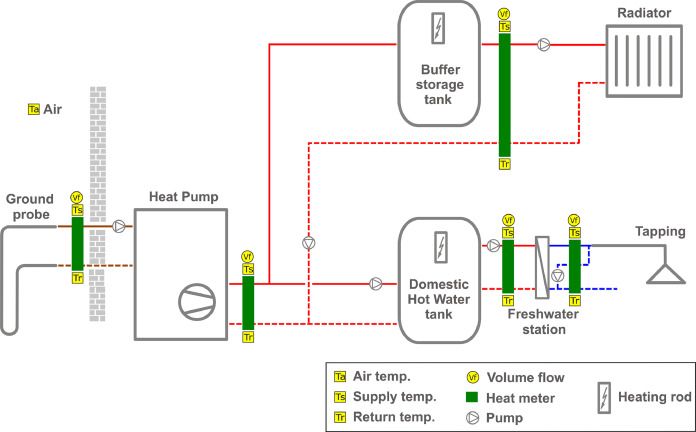
Inquiry
Integrating Home Heat Pumps with Solar PV and Battery Storage
Hydronic system connections for the heat pump systems
Researchers at the Fraunhofer ISE have been exploring the potential of residential rooftop solar power systems, specifically how they can work in tandem with heat pumps and battery storage.
Their study focused on a 1960-built single-family home in Freiburg, Germany, equipped with a system that combined photovoltaic (PV) panels, a heat pump, and battery storage, all managed by a smart-grid (SG) ready control. Shubham Baraskar, a researcher, shared with PV magazine that the smart control effectively increased the operation of the heat pump by raising set temperatures. For instance, the control raised the supply temperature by 4.1 Kelvin for hot water preparation, which resulted in a 5.7% decrease in the seasonal performance factor (SPF) from 3.5 to 3.3. In space heating mode, the smart control reduced the SPF by 4%, from 5.0 to 4.8.
The SPF, akin to the coefficient of performance (COP), differs in that it's calculated over a more extended period under varying conditions.
Baraskar and his team detailed their findings in their study, "Analysis of the performance and operation of a photovoltaic-battery heat pump system based on field measurement data," published in Solar Energy Advances. They noted the primary benefits of PV-heat pump systems are reduced grid consumption and lower electricity costs.
The featured heat pump system is a 13.9 kW ground-source unit with buffer storage for space heating. It also includes a tank and a freshwater station for domestic hot water (DHW) production, both having electric auxiliary heaters.
The solar PV system faces south with a 30-degree tilt angle, boasting a 12.3 kW output and covering 60 square meters. The DC-coupled battery has an 11.7 kWh capacity. The selected house has a heated area of 256 m² and an annual heating demand of 84.3 kWh/m²a.
The researchers explained that the DC power from the PV and battery units is converted to AC through an inverter with a maximum power of 12 kW and a European efficiency of 95%. The SG-ready control interacts with the electricity grid, adjusting the system's operation accordingly. This allows for the reduction of grid strain during high-load periods by turning off the heat pump or activating it in reverse situations.
In the system devised by the researchers, solar power from the PV panels is first used for household needs. Any extra power is then directed to the battery. Only when the house's needs are met and the battery is fully charged is excess energy sent to the grid. Conversely, if the PV system and battery can't fulfill the home's energy needs, electricity from the grid is used.
The team highlighted that the SG-Ready mode kicks in when the battery is either fully charged or charging at its maximum, and there's still surplus solar power. It turns off when the solar power is lower than the house's demand for at least 10 minutes.
Their study, which involved detailed 1-minute data from January to December 2022, looked at self-consumption levels, solar fraction, heat pump efficiency, and the impact of the PV system and battery on heat pump performance. They found that the SG-Ready control raised heat pump supply temperatures by 4.1 K for domestic hot water (DHW) and achieved a 42.9% self-consumption rate over the year, leading to financial savings for homeowners.
The electricity demand for the heat pump was 36% covered by the PV/battery system, with 51% in DHW mode and 28% in space heating mode. However, they noted that higher temperatures reduced heat pump efficiency by 5.7% in DHW mode and 4.0% in space heating mode.
Baraskar pointed out a drawback in space heating: the smart control sometimes caused the heat pump to operate above the necessary heating temperatures due to probable increases in storage set temperature, even when heating was not required. He also mentioned the potential for increased heat loss due to excessively high storage temperatures.
The team plans to explore more combinations of PV/heat pump systems with various configurations and controls in the future. They emphasized that these results are specific to the systems they tested and could vary with different building and energy system specifications.
Our expert will reach you out if you have any questions!

